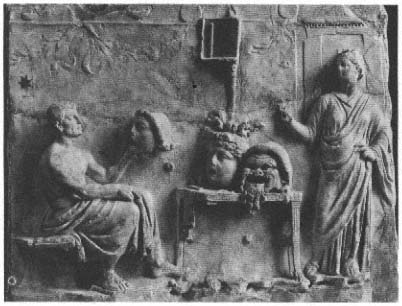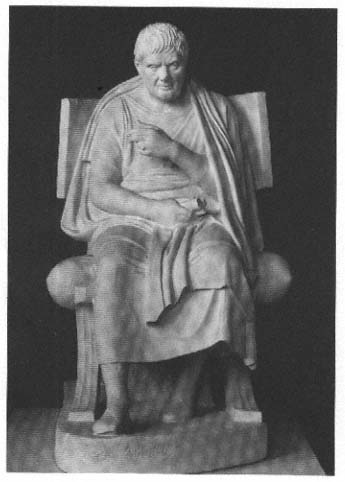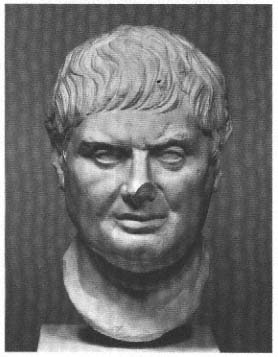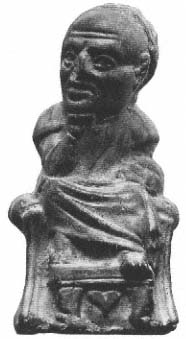Poseidippus: The Hard Work of Writing Poetry
An age that was able to express such subtle distinctions among the various schools of philosophical thought must also have sought ways to express visually the very different activity of the poet. But in fact, in comparison with the rich repertoire of philosophers, the few securely identified portraits of contemporary Early Hellenistic poets seem at first rather a disappointment—at least for the student expecting to find images of poetic inspiration and art.
Menander, as we have seen, was portrayed as a man of fashionable appearance who loved the life of luxury, one considered soft and ostentatious compared to the old polis ideal, but in this way became the model for a new generation in Athens at the beginning of the third century. Yet nothing about his statue refers to his being a poet. The same is true of another seated statue of a poet of similar date, the so-called pseudo-Menander in the Vatican. In its relaxed pose, this statue too expresses the private values of tryphe .[47] It is only on Late Hellenistic copies of the Menander portrait that we may perhaps see an attempt to adjust the facial expression to make it more dramatic.[48] The actual sense of poetic inspiration, however, is first achieved on a group of reliefs that portray a heroized Menander, nude to the waist, in the act of writing, accompanied by his two sources of inspiration, the Muse and the mask (fig. 74).[49] But the original that lay behind these reliefs is a creation of the Late Hellenistic age, probably intended for display in Roman villas. Evidently by this time the stylish Menander of the Early Hellenistic statue was perceived as too bourgeois; what was wanted instead was a more imposing image. This is accomplished above all in the bare chest and the elevated poise of the head.

Fig. 74
Menander with his Muse. First-century B.C. relief. Rome, Vatican Museums.
It would be most interesting to know whether this kind of image of the inspired poet ever carried over into honorific statuary of the Early and High Hellenistic periods, or if it occurs only in the retrospective portraits with which we shall deal in a later chapter. The only work that might be relevant here is the statue of the Attic comic poet Poseidippus (316–ca. 250 B.C. ), of the mid-third century (fig. 75).[50] At first glance, he may be even more disappointing than the Menander, if it is inspiration and spirituality we are after. The head of the inscribed copy in the Vatican, however, with its gloomy countenance, is not that of the Greek poet, but of a Roman of the late first century B.C. who has usurped the statue of a poet to try to pass himself off as a cultivated gentleman. But thanks to a remarkable discovery by Fittschen, we now know the authentic portrait type of Poseidippus in a fine copy of the head. The careless sculptor who reworked the poet's head into that of

Fig. 75
Statue of the comic poet Poseidippus (316–ca. 250). Reconstruction
by K. Fittschen. Göttingen University, Abgußsammlung.
the Roman left a few locks of Poseidippus' hair on the nape of the neck, and these locks enabled Fittschen to recognize the true Poseidippus in a previously anonymous portrait type (fig. 76). It is a massive head, with broad, full face, and had previously been taken to be the portrait of a Late Republican politician, although the existence of a

Fig. 76
Portrait of Poseidippus. Geneva, Musée d'Art et d'Histoire. (Cast.)
herm in the Uffizi with the same portrait type should have suggested otherwise. In short, it is a triumph for good old-fashioned detective work, based on counting locks of hair and a thorough documentation, and, at the same time, a warning not to put too much confidence in a stylistic chronology, especially in Hellenistic art!
Quite unlike Menander, Poseidippus sits with his feet far apart, in a rather inelegant pose, on a chair with an extremely heavy, curved backrest. His legs are awkwardly positioned, the body slightly bent over as if about to cave in. We need only compare the roughly contemporary statues of Epicurus and his circle to realize the full effect of this heavy and pedestrian pose. He is a ponderous, well-nourished gentleman with noticeable paunch. We have already observed in many phi-
losopher portraits how realistically both the physiognomy of the face and the anatomy of the body could be rendered. Realism in the depiction of old age was in those instances not simply a matter of observation or of sculptural style, but the medium of philosophical instruction. Thus we should not assume that the sculptor wanted merely to convey the idea that Poseidippus was a man of ample proportions. Rather, it is more likely that the emphasis on the plump body and massive head carries a more general message. Probably it alludes to the ideal of Dionysiac extravagance and tryphe that was especially favored at the court of the Ptolemies. Certainly the cooks play important roles in the plays of Poseidippus, and in New Comedy in general, and this too is not unrelated to the notion of tryphe as a way of life.[51] It seems that in the third century, the well-fed body and full face were considered attractive, especially once the Ptolemies, as the protagonists in this new Dionysiac ethos, had themselves so depicted.[52] Indeed, the changing preference for thinner or heavier bodies in different time periods is, in the end, also a symbolic expression of particular social values.
This is not the only respect in which the portrait of Poseidippus seems to conform to the fashion of his age. Like Menander, he is also clean-shaven, and the same is true of the relatively few portraits of other Hellenistic poets that can be recognized as such among preserved Roman copies. In the light of our earlier discussion of beards and their connotations, this could hardly be an insignificant detail. Evidently, poets tended to follow contemporary fashion, unlike the philosophers, and did not perceive themselves in the same way as distanced from society at large or as the guardians of traditional values.
Poseidippus' fleshy face has, in addition, a peculiar expression (fig. 76). Although the brows are again drawn together, the nervous and agitated play of the features does not convey a sense of strain and intellectual effort, as in the Stoic philosophers. Instead, the mouth is relaxed and slightly open, while the eyes do not look straight at us but are directed somewhat downward. It seems that the artist was indeed trying to convey something of the laborious process of composing verse. The unusual pose of the raised arm with relaxed, open hand could suggest that he is keeping time, unconsciously rehearsing the
meter as he searches for just the right word. The closest parallel for the raised arm is on a copy of the Menander relief that Margarete Bieber recognized as the original, Late Hellenistic version. One may also be reminded of the depiction of a young poet on a Roman funerary altar of Trajanic date.[53] If this is indeed the key to the correct interpretation, then we might go further and see the loose and gawky seated posture as an expression of "abstractedness," a consequence of his concentration on the poetic process. A comment of Pliny the Elder (HN 35.106) suggests that in other media of Early Hellenistic art as well there were indeed images of poets with their own particular expression. In describing a work by the painter Protogenes, he mentions the Alexandrian tragic poet Philiskos, a contemporary of Ptolemy II, represented "in a meditative pose" (meditans ). This description recalls a fine caricature in terra-cotta of the late third century B.C. that was found in Olympia but was made in Alexandria (fig. 77).[54] It represents a poet deep in meditation, his massive head weighed down by heavy thoughts. The pose of the body could well be inspired by an honorific statue, as a comparison with the thinker in the Palazzo Spada suggests (fig. 57). Footstool and pillow once again allude to the private sphere, while the contrast between the simple chair and the elevation of the figure, as if on a throne, is evidently an element of caricature. It comes as no surprise that this testimonium to the mockery of intellectuals should have originated in Alexandria.
Poetry, then, is characterized in the statue of Poseidippus not as a stroke of ecstatic inspiration, but as a long and strenuous and not especially enjoyable process. One would be tempted to speak of the "forging of verses" if this did not conjure up an unfortunate association with Wagner's Meistersinger . The parallel with the statues of Stoic philosophers is obvious, though the difference is also clear. The poet's work is not strictly a matter of a powerful act of will, but more of searching, of listening to his inner voice, of feeling his way. The public aspect is here fully suppressed. Though the form of the statue is a conventional one, the poet behaves quite differently from Menander. Like the statues of the reading philosopher, this one also gives the viewer the impression of peering unobserved into a private and intimate world, almost of being a voyeur.

Fig. 77
Caricature of a tragic poet (?). Alexandrian
terra-cotta statuette, late third century B.C.
Olympia, Museum.
The movement of the right arm, as well as the introverted facial expression, is strikingly reminiscent of Joshua Reynolds's portrait of 1769 of the writer Dr. Samuel Johnson.[55] One wonders whether Reynolds might have drawn inspiration from the statue in the Vatican, already well known then, or if the ancient and modern artists arrived independently at the same psychological insights.